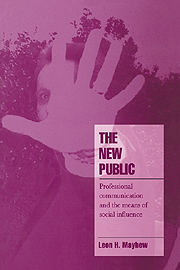Preface
Published online by Cambridge University Press: 06 September 2009
Summary
The New Public began to take shape in 1988, when, faced with several months of bed rest, I entertained myself by watching the American electoral campaign on television. In the course of watching and reading about the campaign, I became convinced that one element of sociologists' longstanding response to the radical critique of mass society requires substantial revision. Critics of the notion of mass society assert that the mass public is not so vulnerable to manipulation by elites as might be imagined. Messages of elite communicators can be rejected or reinterpreted by the public as its members pass their views from one member to another within their private groups and circles. The “two-step flow of communication” is still present and can thwart the intentions of influential spokespeople, but what about the reverse flow of communication from the public to its leaders? Are the views of the public transmitted along comparable lines of social organization? I contend that the rationalization of public persuasion and its consequent domination by professional communicators erodes the social organization of public opinion. Rationalized techniques employed in systematic campaigns rely on market research to learn what the public believes and wants, or what is likely to prove persuasive. In consequence, public opinion loses its social moorings; it becomes less organized by social groups that create and transmit public views and more affected by what market research determines to be hot-button appeals.
- Type
- Chapter
- Information
- The New PublicProfessional Communication and the Means of Social Influence, pp. ix - xiiPublisher: Cambridge University PressPrint publication year: 1997

